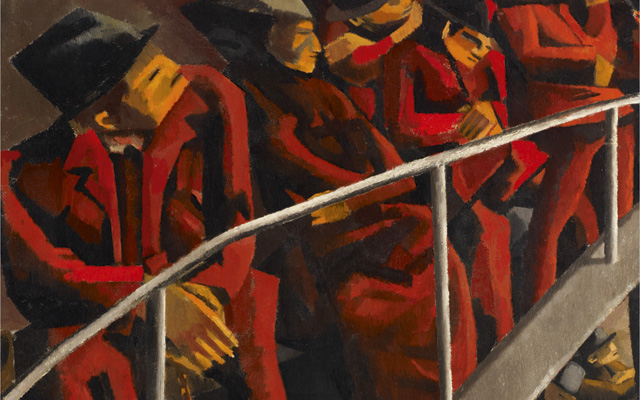Out of Chaos: Ben Uri: 100 Years in London
Catherine Milner is impressed by powerful works by Jewish artists.


Between 1880 and 1933, more than a quarter of a million Jews came to Britain, fleeing from horrors in Russia, Germany, Poland, Italy and other parts of Europe. Many of them settled in the East End of London and, in 1915, above Gradel’s restaurant in Whitechapel, a Russian émigré and artist, Lazar Berson, clubbed together with his friends to set up Ben Uri, originally called The Jewish National Decorative Art Association (London), ‘Ben Ouri’, to nurture Jewish creativity.
Named after Bezalel Ben Uri, the biblical creator of the tabernacle in the Temple of Jerusalem, the society became a cultural home for émigrés, most of whom spoke Yiddish and were unable to penetrate the bastion of the British art world. They attended literary evenings, played music and, through paying a sub-scription, bought works by Jewish artists.

A century on, the collection comprises more than 1,300 works by some 380 artists. It is now temporarily based in St John’s Wood, but 67 works are currently on show at Somerset House, in a small but powerful exhibition that highlights how influential Jewish artists in this country have been. Whitechapel Boy David Bomberg, as well as Jacob Epstein, Kurt Schwitters, Leon Kossoff, Lucian Freud and Frank Auerbach, are just some who have revolutionised British art.
And it wasn’t just the artists art galleries such as Marlborough Fine Art and Crane Kalman, which were set up by Jewish émigrés, created a taste for German Expressionist art that challenged the pale linear restraint of Sir William Cold-stream, Victor Pasmore, Paul Nash and other stars of the British art scene in the 1940s and 1950s.
Many Jewish artists taught in British art schools; the Royal Academician Gillian Ayres says of Martin Bloch, her former tutor at Camberwell, that he ‘swept the life room’. Bomberg’s pupils at Borough Polytechnic included Auerbach and Kossoff. And their impact was also felt in the sphere of art historical research, with the establishment of institutions such as the Warburg Institute, which turned art history from a dilettante’s pastime into a serious academic discipline.
This exhibition is significant, not only because it heightens awareness of a culture under renewed threat (anti-Semitic attacks doubled in 2014, according to the Community Security Trust), but also in its present-ation of the notion of a Jewish aesthetic. It is laid out largely chronologically; the dark realism of haunted, hunted migrants fleeing Russia at the end of the 19th century depicted by artists such as Victor Hageman give way to more fluid German Impressionist paintings by the likes of Max Liebermann.
A self-portrait of Liebermann, done in 1927, looks down from the walls of one of the first rooms in the exhibition, his hollow, red-rimmed eyes anticipating, it seems, the pain that was to come. In 1938, much of his work was stripped from the walls of museums in Germany and destroyed by the Nazis, who denounced it as ‘degenerate’.
Exquisite houses, the beauty of Nature, and how to get the most from your life, straight to your inbox.
In another room hangs the last self-portrait that Isaac Rosenberg did before he was killed near Arras in France in 1918. Drawn in black chalk with white and yellow gouache on brown paper probably retrieved from a parcel, it’s a humble memorial to one of the greatest poets of the First World War.
Mark Gertler’s most celebrated painting, The Merry-Go-Round, is in the same room, but it’s one of his watercolours, done on the eve of the First World War, that steals the show: a portrayal of a Rabbi and his wife, with eyes like saucers, hands like spades, yoked together in fear.
Only a handful of pictures depict the Holocaust, largely because artists who had suffered because of it, either directly or by losing relatives, rarely depicted it. Instead, it bled into their work in other ways: through the living cadavers favoured by Lucian Freud or the sanguinary colours used by Josef Herman.
Exceptions were Jankel Adler, whose painting of a pair of orphans is one of the most piercing in the catalogue, and Feliks Topolski, whose spidery sketches of concentration-camp prisoners tell of his emotional depletion.
Ben Uri has now morphed from being solely about Jewish art into an entity that promotes the cultures of all migrants living in this country. As its Executive Chairman, David Glasser, says in his catalogue essay: ‘Museums can play an important role in enabling social integration.’ Unfortunately, the weakest pictures in the exhibition are the most recent photographs, videos and abstract paintings investigating ‘hier-archies of victimhood’, as grey and forgettable as they are earnest.
In the catalogue, there is a photo from the Chapman brothers’ gruesome but brilliant sculpture Hell, showing dead Nazis hanging from the trees, but, otherwise, challenged no doubt by the extortionate prices commanded by Grayson Perry, Yinka Shonibare and other modern masters who have made pieces about migration, the curators have opted for works far drearier.
‘Out of Chaos: Ben Uri: 100 Years in London’ is at Inigo Rooms, Somerset House East Wing, Strand, London WC2, until December 13 (www.benuri100.org)
Country Life is unlike any other magazine: the only glossy weekly on the newsstand and the only magazine that has been guest-edited by His Majesty The King not once, but twice. It is a celebration of modern rural life and all its diverse joys and pleasures — that was first published in Queen Victoria's Diamond Jubilee year. Our eclectic mixture of witty and informative content — from the most up-to-date property news and commentary and a coveted glimpse inside some of the UK's best houses and gardens, to gardening, the arts and interior design, written by experts in their field — still cannot be found in print or online, anywhere else.
